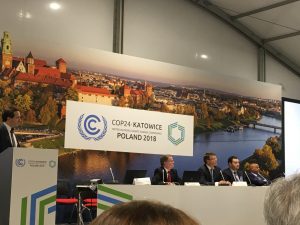Although not a new topic at the Conference of the Parties, little policy headway has been made in the realm of loss and damage. Loss and Damage was first given significant attention at COP19 with the formation of the Warsaw Implementation Mechanism (WIM) and was specifically addressed in Article 8 of the Paris Agreement. The recent IPCC report emphasizing the importance of keeping the global temperature increase below 1.5˚C has provided increased urgency to find an appropriate way to approach loss and damage in the framework. With COP24 marking the 5th anniversary of the WIM and the implementation of the Paris Rulebook, there was a high level of hope surrounding loss and damage progress, but here on the last day of the COP, many questions still remain.

Loss and Damage at the German Pavilion
At a loss and damage event held by Germany towards the end of week 2, a member of the German Parliament and three experts discussed the many difficulties associated with defining the loss and damage problem and the mechanisms to deal with such problems. Not only were the panelists at this event brilliant, the audience members asked perhaps the most insightful questions I heard all week. Questions were asked about the appropriateness of financing loss and damage through the UNFCCC, at what level ecological loss and damage is considered, and how should loss and damage be framed in order to communicate its importance to government officials and younger generations. The panelists gave insightful answers stressing the perverse idea that those least responsible for and most effected by climate change should be required to buy insurance to cover “unprecedented events” that are no longer unprecedented. They also discussed the problems with giving loss and damage its own article under the rulebook and the difficulties of valuing noneconomic losses. By the end of this incredibly interesting discourse, it was clear that we are far away from addressing loss and damage in a sufficient way.
On the actual negotiations side of the issue, large effort is being made by developing countries to avoid absorbing loss and damage in adaptation. Separating loss and damage and adaptation has resulted in a cornucopia of potential solutions to help account for loss and damage. Deputy director of the Risk and Resilience (RISK) research program at the International Institute for Applied Systems Analysis Reinhard Mechler stated earlier this week “Loss and damage must be reflected separately throughout the Paris Rulebook: in finance, accounting, transparency and the global stocktake.” But even with so many countries and non-party members advocating for dynamic solutions, there has been no clear path to move forward.

Polish Pavillion
As I mentioned earlier, this year marked the 5th Anniversary of the WIM, which set out to “address loss and damage associated with impacts of climate change, including extreme events and slow onset events, in developing countries that are particularly vulnerable to the adverse effects of climate change,” but this mechanism has yet to produce any tangible results, like many of the negotiations that were once thought so vital for the outcome of COP24.
As I complete my final post, I would like to leave you with the words the UN Secretary General shared with us this afternoon “I have no doubts some of you may be disappointed—perhaps I will leave here disappointed—but I want you to never give up!”
 Before arriving at the COP, really before the start of the semester, I had what I now realize was an idealized vision of UNFCCC negotiations and outcomes. I assumed that parties negotiated over big picture issues, not between the words “should” and “shall”, and that the outcomes of such negotiations would be easily implemented. Upon studying the history of past agreements throughout the semester and attending multiple side events here in Katowice regarding the complexity of the technical aspects of the Paris Agreement, I know my original assumptions not to be the case.
Before arriving at the COP, really before the start of the semester, I had what I now realize was an idealized vision of UNFCCC negotiations and outcomes. I assumed that parties negotiated over big picture issues, not between the words “should” and “shall”, and that the outcomes of such negotiations would be easily implemented. Upon studying the history of past agreements throughout the semester and attending multiple side events here in Katowice regarding the complexity of the technical aspects of the Paris Agreement, I know my original assumptions not to be the case.
 Poland is a country with a frequently fluctuating climate. While hurricanes were already common in Poland, the country has seen a
Poland is a country with a frequently fluctuating climate. While hurricanes were already common in Poland, the country has seen a 